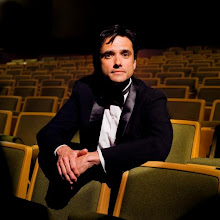Wednesday, October 08, 2008
By WILLIAM KELLY and JAN SJOSTROM
Daily News Staff Writers
Click-2-Listen
The developers who control the Royal Poinciana Plaza are unveiling their long-awaited preliminary plan to revitalize the John Volk-designed retail center at Palm Beach's northern gateway.
The plaza they envision is greener than today's — with open vistas, parks and less visible parking.
What it doesn't have is the Royal Poinciana Playhouse.
Sterling Palm Beach, which took control of the plaza April 1, began Monday to present the preliminary plan to small "focus groups," including Town Council members, town board members and other community leaders.
The developers said the plan would revitalize the plaza while reflecting the desires of the community as communicated through a charrette held early this year.
It reflects the community's desire to reduce density and retain businesses that are "town-serving," developer Lee Munder said.
Sterling estimated that the non-income-producing aspects of the project would cost almost $100 million.
"It's a very expensive build, but we wanted to provide the town with a lot of what they asked for," Munder said.
The proposal calls for razing all but the Playhouse's east facade, which would remain to link two residential buildings facing a 1.1-acre waterfront park. A restaurant would occupy the ground floor of one building.
The plan developed by project architect Ann Beha and landscape architect Morgan Wheelock would move the plaza closer to Volk's original vision of strong geometric forms, light-colored exteriors, formal greenery and open vistas, Wheelock said.
"The theater facade is prominent and well-placed," Beha said. "All the rest of the components are workman-like boxes that are not designed in the Regency Style."
A smaller, 350-seat performing arts venue, estimated to cost $15 million to $20 million, would be erected where the Slat House now stands. It would face a pocket park and pool that would reflect the large banyan tree on the south side of the property.
The view-obstructing Gucci Courtyard would be replaced with a shaded lily pond and outdoor seating area, surrounded by eateries.
"We really wanted to energize the center of the property," said Wheelock, who also is chairman of the town's Architectural Review Commission.
The developers are seeking suggestions to help them tweak the plan in advance of its presentation to the Town Council Nov. 12. The plan will be on view to the public in early November, they said.
Sterling would recoup its investment by selling 30 homes scattered throughout four buildings, Munder said.
Zoning change needed
Residential use of the 12-acre plaza site would require a zoning change, in addition to zoning variances and site plan review.
Sterling faces a hearing at the Nov. 12 meeting to determine if some or all of the plaza will be landmarked as the Landmarks Preservation Commission has recommended.
Lee Munder said the development group hopes the council will landmark the two main Volk-designed buildings that form the backbone of the 1957 shopping center. But he said the other buildings shouldn't be landmarked.
"We've been blown away with the reception we've received," said Adam Munder, another of the developers.
"I was very impressed," Councilman Denis Coleman said. "They have obviously expended a large amount of effort, and the result so far reflects a sensitivity to the issues that are most important to the people I've heard from in the community."
But Coleman said he wasn't ready to comment on razing the Playhouse and building homes.
Earlier plans, by another group of developers, to tear down the Playhouse and build condos were withdrawn in 2005 because of public opposition.
Councilwoman Susan Markin said the developers have devised a proposal that would let them turn a profit while responding to the interests of the community.
Markin said she likes the concept of building a theater away from the waterfront while preserving the Playhouse's east facade. She favors the additional greenery and found the parking arrangements clever.
The crescent shape of the waterfront residential buildings would soften their impact on the lake, she said. But Markin said she would prefer to see the number of homes reduced to somewhere below 30.
"I'm glad they're keeping the Regency style, because it has some uniqueness and I like that," she said. "I think they've got the basics of a very good plan. They did as good of a job as any developer could do."
John Mashek, president of the board of directors of the Preservation Foundation of Palm Beach, said he regards the plan as a work in progress.
"The Preservation Foundation continues to feel the whole property should be landmarked and that we should let the landmarks commission work with the developer on the changes they want," he said. "That's the process."
'About saving the architecture'
But he said that doesn't mean the Playhouse should remain intact.
"We are not about the usage of historic buildings," he said. "We are about saving the architecture itself."
Patrick Flynn, president of the Palm Beach Theater Guild, which wants to operate the Playhouse, dismissed the plan to raze it as "the same old, same old."
He said the guild will continue to push to get the theater landmarked. He added that the Playhouse is protected by a 1979 property-use agreement between the plaza owners and town.
Landmarks Commissioner Bob Eigelberger said he views the plan as far from final. But he said there are parts about which he is enthused.
"Obviously, having 6.7 acres of green space, as opposed to [the current] 3.2 acres, on a 12-acre site is very exciting," he said. "They're adding more parking and it's underground. That's interesting."
He also liked the plan to extend the bicycle path and add outdoor dining.
"I'm excited that the main architectural features will be preserved. As far as what they're adding or reducing in terms of structures and the heights of the buildings — all that has to be negotiated."
__________________________________________
"Dear Mr. Flynn,
My name is James A. Crockett and I am the House Sound Designer and Senior Staff Member at the Cuillo Centre for the Arts on Clematis Street in West Palm Beach.
I was pleased to receive your article regarding the demolition of the Royal Poinciana Playhouse. It certainly disturbs me that such a fine institution is being considered for destruction.
Please continue to write me with any suggestion on how I may be of assistance to you in preserving this distinctive and cultural landmark.
Sincerely,
James A, Crockett
House Sound Designer"
Subscribe to:
Post Comments (Atom)



















No comments:
Post a Comment